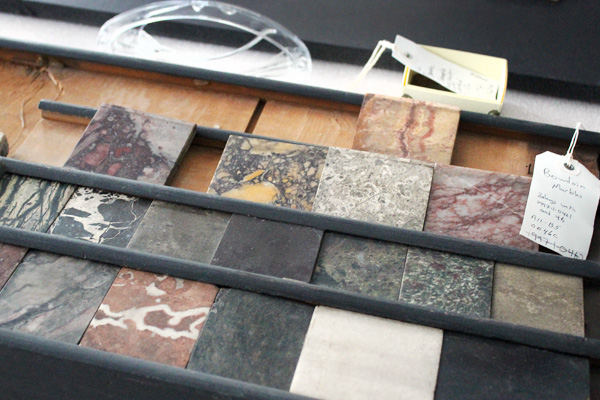On a warm, quiet morning in June, more than a dozen people from across campus stood around a table at the university’s Collection of Historical and Scientific Instruments (CHSI), peering over small marble squares. CHSI director Jean-Francois Gauvin and curator of the collection Sara Schechner facilitated the examination. Tony Sigel, conservator of objects and sculpture in the Harvard Art Museums’ Straus Center for Conservation and Technical Studies, held an ultraviolet lamp over one of the squares. As the lights dimmed, everyone slipped on special viewing glasses.
“Ready?” Sigel said. “Let’s take a look.”
With the lamp’s purple glow cast over the square, people began calling out letters and numbers that seemed to appear on the marble’s surface.
“I see a J!” “This could be an S or a T.” “That could be two letters—two Rs?”
Ethan Lasser, the Margaret S. Winthrop Associate Curator of American Art, and others from the Straus Center, CHSI, and the Mineralogical and Geological Museum at Harvard (MGMH) believe that the writing is part of an early labeling system for objects that were once installed in Harvard’s Philosophy Chamber. From 1766 to 1820, this large, ornately decorated Harvard College room held an astounding collection of portraits, prints, scientific instruments, “curios” obtained abroad by Harvard graduates, and more.
As the group examined each piece of marble, they detected more faint labels. Some seemed cryptic, while others were straightforward—“English marble” and “Middlebury, Vermont,” for instance. Even those with clearly discernable words, however, will require additional research.
This detective work is just a tiny portion of the fact-finding being undertaken in preparation for a future Harvard Art Museums exhibition, curated by Lasser, about the Philosophy Chamber. When the chamber was dismantled in 1820, the collection was dispersed across university departments and other Boston institutions. The exhibition will reunite many of those objects for the first time since the early 19th century.
“I kept coming across references to the Philosophy Chamber in my research for other projects, but no one had really documented it before,” said Lasser, who last fall co-taught a course about the chamber with Jennifer Roberts, the Elizabeth Cary Agassiz Professor of the Humanities. “The Philosophy Chamber played an important role in Harvard’s early history, and it was a celebrated public space that drew visitors from around the world. Studying the Philosophy Chamber today can tell us a great deal about the role that images and objects played in building, organizing, and transmitting new knowledge.”
Plans for the exhibition were under way as early as 2013, when Lasser began sorting through various Harvard archives and tracking down objects from the chamber. He and Lola Sanchez-Jauregui, the Maher Curatorial Fellow in American Art, then narrowed the list of objects to approximately 100 for display in the exhibition. About 90 percent of those objects are still in Harvard’s possession, while 10 percent will be loaned from other institutions. Objects include a number of paintings by John Singleton Copley (such as Nicholas Boylston), slides for a compound microscope that date to around 1798 (from CHSI), and ancient coins.
There will be more research in the coming months, including X-ray examinations of a Copley painting to gain insight into the work’s creation, and an effort to measure the original dimensions of the Philosophy Chamber so that it can be replicated in the galleries. Stay tuned as we offer more behind-the-scenes peeks at the various stages of work required to put together this exciting exhibition.


